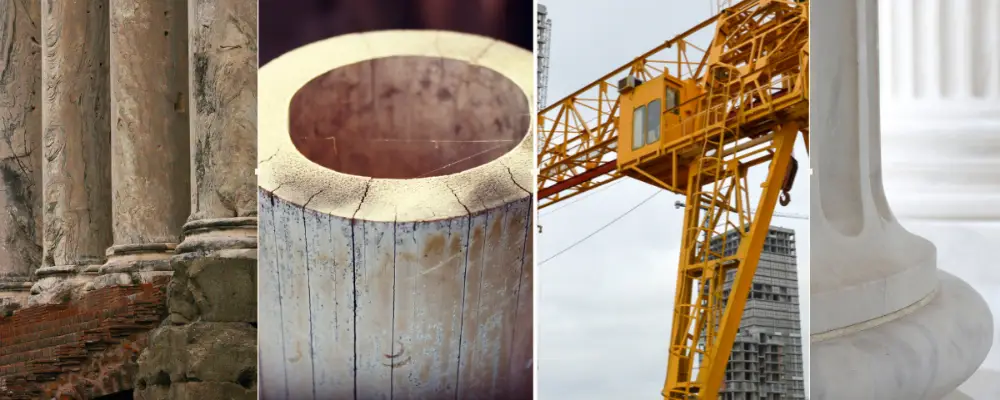Wood columns have played a crucial role in architecture since ancient days. It is primarily used in residential construction, known for its structural support and aesthetic appeal. Over time, wood columns have evolved in various designs, shapes, and sizes to meet modern architectural needs. Choosing the wise option adds a unique charm and beauty to homes along with structural integrity.
They are also known as pillars or posts, providing support to withstand the weight of the structure. By blending with modern technology, the use of wood columns continues these days.
This article explains what a wood column is, its types, advantages, and maintenance works. Continue your reading to understand them in detail:
What is a Wood Column?
A wood column is a vertical structural component designed to withstand loads and transfer them safely to the foundation. It is made from timber and used in various constructions such as pergolas, homes, and decks. They come in numerous styles, shapes, and sizes, each with its own characteristics and capacities.
The appropriate selection ensures long-term performance and durability. Right now, wood columns are the most popular choice, offering both aesthetic and functional value to your properties.
Types of Wood Used for Columns
Wood columns are widely classified into four different types based on their design and construction. Here is their explanation:
Solid Wood Columns
Solid wood columns are primarily known for their greater strength and durability. It is constructed from a single piece of wood, often used in structural applications. A solid wood column is widely used in places where the load-bearing capacity is essential.
Hollow Wood Columns
Hollow wood columns are assembled around the central core, which is constructed using multiple pieces of wood or plywood. Due to their lightweight and easier installation process, they have become an ideal choice for construction compared to solid wood columns. It can elevate your structure’s appearance and make it unique. But they have lower load-bearing capacity compared to solid wood columns
Non-Load-Bearing Columns
Unlike other wood columns, non-load-bearing columns are not specifically designed to withstand any significant weight. They are purely used for decorative purposes and create dramatic and visually appealing interest in a space where the structural support is not necessary.
Fluted Columns
Fluted columns are another well-known decorative element to fuel the structural design. They feature vertical grooves or channels along their length and can be made from solid or hollow wood. It is widely noticed in classical architecture.
Installation and Maintenance of Wood Columns
Proper installation and maintenance is paramount to ensuring long-term stability and performance. It doesn’t matter where we are using; continuous care and maintenance can uplift their longevity. However, here are some of the installation and maintenance tips provided; make use of them:
Proper Alignment: Proper alignment of the columns is crucial for even load distribution. When the wood columns are properly arranged, they can evenly bear the load and transfer them to the foundation without any structural issues.
Strong Column Foundation: Provide extra care and attention to the design and construction of column foundation. It not only prevents costly impacts but also provides essential support to the structural weight.
Regular Painting or Staining: Wood columns may be susceptible to peeling or fading over time. It harms the natural beauty and aesthetic appeal of wood grain. So, painting or staining them regularly can protect wood columns from all such harmful elements.
Regular Inspection: Regular inspection is advisable to identify the signs of damages like infestation, cracks, or rot in advance. Providing early treatment can avoid further repairs.
Advantages of Wood Columns
Wood columns have been a popular choice in architecture for centuries. They offer numerous advantages to the construction, such as:
Structural Support: Wood columns are fundamental elements in residential construction to support the load of the floors and beams above them. They are mostly used in classical and traditional architectural styles, transferring the weight to the foundation. Properly designed and maintained wood columns stay away from settling, sagging, and other structural problems that occur over time.
Aesthetic Appeal: Beyond structural support, they offer unique design and detailing to a home. As mentioned earlier, wood columns come in a variety of styles and shapes that enhance the overall look and feel of your home.
Comfort: Wood is more comfortable and warmer than other materials like concrete or steel. They prettily absorb the sound and keep the interior environment calm and peaceful.
Disadvantages of Wood Columns
Though wood columns offer several advantages to the construction, they also have some potential drawbacks, such as:
Regular Maintenance: Wood columns often require inspection and maintenance to improve the performance and longevity of structural support. If any signs of damage are found, it needs to be repaired immediately.
Susceptible to Damage: Wood columns are highly prone to moisture damage, decay, or mold. To mitigate these risks, wood columns should be treated with fire retardants, preservatives, and other protective chemicals.
In a Word
Wood columns are an essential element that provides both structural support and aesthetic appeal to the construction. By understanding the various types of wood columns and their individual properties, you can make informed decisions when constructing your home.
FAQs
Wood columns are available in various sizes based on building codes, structural requirements, and aesthetic preferences., Typically ranging from small 4×4 inches to large 12×12 inches and more. It is advisable to consult your structural engineer to determine the exact size required for your specific project.
For structural purposes, hardwoods like hickory, oak, or maple are the best choices to go. If you are looking for weather-resistant or desired aesthetic appeal, the choices of wood selection may vary.
In general, teak wood is the highest quality wood used in most of the furniture work. Sal, deodar, oak, rosewood, acacia, and mahogany are the other types of quality woods, which are exceptional in durability and fire resistance.

